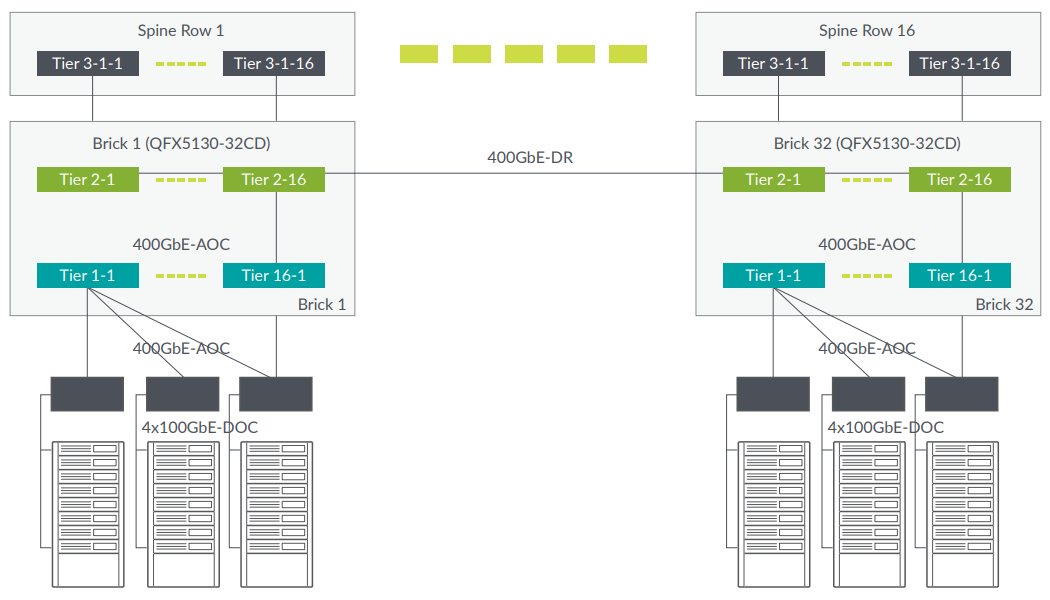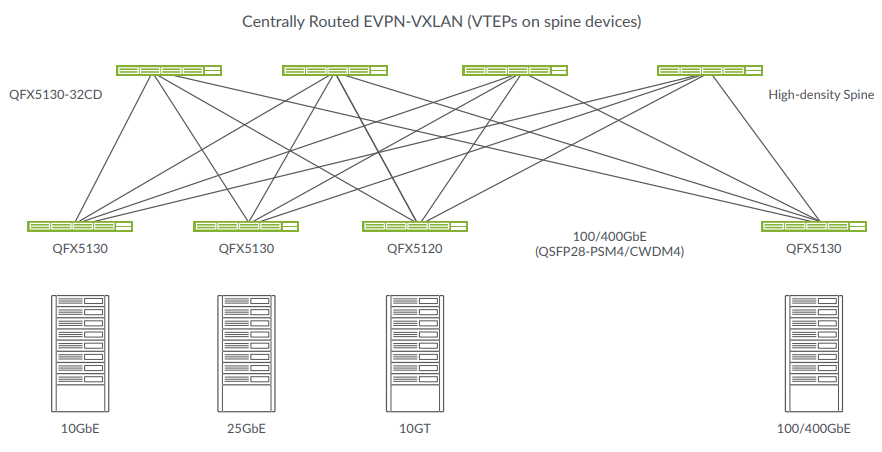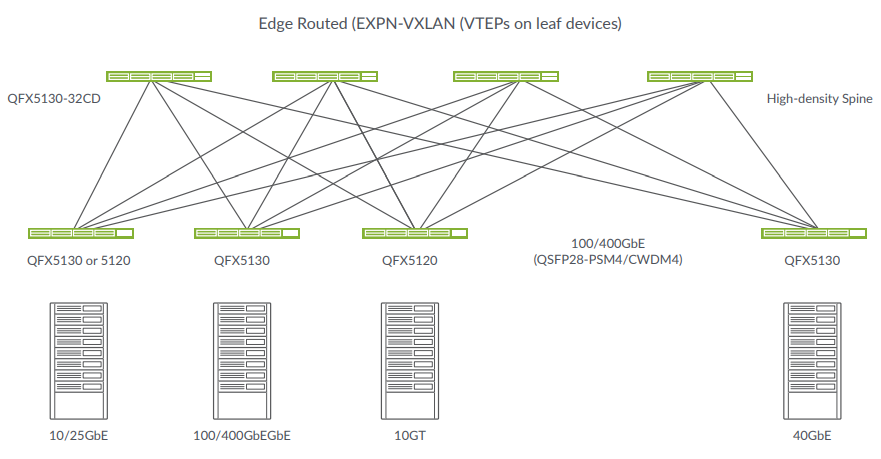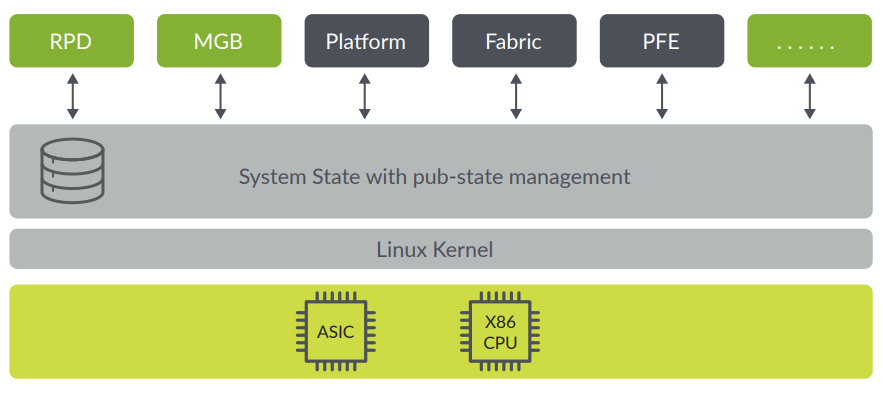Overview:
QFX5130 Switches offer a high-density, cost-optimized 1U, 400GbE fixed configuration ideal for data centers where cloud services are being added. These services require higher network bandwidth per rack, along with flexibility, making the 10/25/40/100/400GbE interface options ideal for server and intrafabric connectivity. The QFX5130 is an optimal choice for spine and leaf deployments in enterprise, service provider, and cloud provider data centers.
Organizations requiring scale-out networks to run applications dependent on sophisticated traffic-handling with in-band telemetry and traffic steering based on dynamic state will benefit from Juniper’s compact, value-based solution. Coupled with the widespread adoption of overlay technologies, the QFX5130 Switch lays a strong infrastructure foundation for your evolving business and network needs. With deployment versatility to multiple applications, from custom services delivery in provider networks to breakthrough AI applications and scientific research, the platform brings future-proof flexibility to your network investment.
The QFX5130 comes in one model:
- QFX5130-32CD: data center leaf or spine with 32 x 400GbE and 2 x 10GbE port
Product Description
The Juniper Networks QFX5130 Switch is a next-generation, fixed-configuration spine-and-leaf switch that offers flexible, cost-effective, high-density 400GbE, 100GbE, 50GbE, 40GbE, 25GbE, and 10GbE interfaces for server and intra-fabric connectivity.
A versatile, future-proofed solution for today’s data centers, the QFX5130 leverages the power of a fully programmable chipset to support and deliver a diverse set of use cases. It supports advanced Layer 2, Layer 3, and Ethernet VPN (EVPN)- Virtual Extensible LAN (VXLAN) features. For large public cloud providers—early adopters of high-performance servers to meet explosive workload growth—the QFX5130 supports very large, dense, and fast 400GbE IP fabrics based on proven Internet scale technology. For enterprise customers seeking investment protection as they transition their server farms from 10GbE to 25GbE, the QFX5130 switch also provides a high radix-native 100GbE/400GbE EVPN-VXLAN spine option at reduced power and a smaller footprint.
The QFX5130 supports diverse use cases such as neural networks for AI applications, including autonomous driving, disaggregated storage, high frequency trading, packet brokering, and over-the-top streaming services. Delivering 25.6 Tbps of bidirectional bandwidth, the switch is optimally designed for spine-and-leaf deployments in enterprise, high-performance computing (HPC), service provider, and cloud data centers.
The QFX5130-32CD offers 32 ports in a low-profile 1 U form factor. High-speed interfaces support a wide variety of port configurations, including 400GbE, 100GbE, 25GbE, 40GbE, and 10GbE. The QFX5130-32CD is equipped with two AC or DC power supplies, providing 1+1 redundancy when all power supplies are present. Six hot-swappable fans offer back-to-front (AFO) or front-to-back (AFI) airflow options, providing 5+1 redundancy.
The QFX5130 includes an Intel XeonD-1500 processor to drive the control plane, which runs the Junos OS Evolved operating system software.
Highlights
The QFX5130 includes the following capabilities. Please refer to the Specifications section for currently shipping features.
- Native 400GbE Configuration
The QFX5130-32CD offers 32 ports in a 1 U form factor. The high-speed ports support a wide variety of configurations, including 100GbE and 40GbE.
- High-Density Configurations
The QFX5130 is optimized for high-density fabric deployments, providing options for 32 ports of 400GbE, 100GbE, or 40GbE.
- Flexible Connectivity Options
The QFX5130 offers a choice of interface speeds for server and intra-fabric connectivity, providing deployment versatility and investment protection.
Key Product Differentiators
Increased Scale and Buffer
The QFX5130 provides enhanced scale with up to 1.24 million routes, 80,000 firewall filters, and 160,000 media access control (MAC) addresses. It supports high numbers of egress IPv4/ IPv6 rules by programming matches in egress ternary content addressable memory (TCAM) along with ingress TCAM.
132MB Shared Packet Buffer
Today’s cloud-native applications have critical dependency on buffer size to prevent congestion and packet drops. The QFX5130 has 132 MB shared packet buffer that is allocated dynamically to congested ports.
Programmability
The QFX5130 revolutionizes performance for data center networks by providing a programmable software-defined pipeline in addition to the comprehensive feature set provided in the Juniper Networks QFX5120 Switch line. The QFX5130 uses a compiler-driven switch data plane with full software program control to enable and serve a diverse set of use cases, including in-band telemetry, fine-grained filtering for traffic steering, traffic monitoring, and support for new protocol encapsulations.
Power Efficiency
With its low-power 7 nm process, the QFX5130 consumes a maximum of 973 W, bringing improvements in speed, less power consumption, and higher density on chip.
Deployments:
The QFX5130-32CD can be deployed as a universal device in cloud data centers to support 100GbE server access and 400GbE spine-and-leaf configurations, optimizing data center operations by using a single device across multiple network layers (see Figure 1). The QFX5130-32CD can also be deployed in more advanced overlay architectures like an EVPN-VXLAN fabric. Depending on where tunnel terminations are desired, the QFX5130-32CD can be deployed in either a centrally routed (Figure 2) or edge-routed (Figure 3) architecture.
| Port Combinations |
Switch |
Deployment |
| 128x100GbE |
QFX5130-32CD |
100GbE access or leaf |
| 128x25GbE |
QFX5130-32CD |
25GbE access or leaf with 25GbE break out |
| 128x10GbE + 2 SFP+ ports |
QFX5130-32CD |
10GbE access or leaf with 10GbE break out |
| 32x400GbE |
QFX5130-32CD |
400GbE spine |
| 32x100GbE |
QFX5130-32CD |
100GbE spine or leaf |
| 32x40GbE |
QFX5130-32CD |
40GbE access or leaf |

Figure 1: Typical cloud data center deployment for the QFX5130-32CD

Figure 2: QFX5130-32CD as a 100GbE/400GbE ToR in a typical cloud data center

Figure 3: Private cloud data center with the QFX5130-32CD as high-density spine
Architecture and Key Components:
The QFX5130 can be used in L3 fabrics and L2 networks. You can choose the architecture that best suits your deployment needs and easily adapt and evolve as requirements change over time. The QFX5130 serves as the universal building block for these switching architectures, enabling data center operators to build cloud networks in their own way.
Layer 3 fabric: For customers looking to build scale-out data centers, a Layer 3 spine-and-leaf Clos fabric provides predictable, nonblocking performance and scale characteristics. A two-tier fabric built with QFX5130 switches as leaf devices and Juniper Networks QFX10000 modular switches in the spine can scale to support up to 128 40GbE ports or 128 25GbE and/or 10GbE server ports in a single fabric.
Junos OS Evolved ensures a high feature and bug fix velocity and provides first-class access to system state, allowing customers to run DevOps tools, containerized applications, management agents, specialized telemetry agents, and more.
Junos Telemetry Interface
The QFX5130 supports Junos telemetry interface, a modern telemetry streaming tool that provides performance monitoring in complex, dynamic data centers. Streaming data to a performance management system lets network administrators measure trends in link and node utilization and troubleshoot issues such as network congestion in real time.
Junos telemetry interface provides:
- Application visibility and performance management by provisioning sensors to collect and stream data and analyze the application and workload flow path through the network
- Capacity planning and optimization by proactively detecting hotspots and monitoring latency and microbursts
- Troubleshooting and root cause analysis via high frequency monitoring and correlating overlay and underlay networks

Figure 1: Cloud/Carrier-Class Junos OS Evolved Network Operating System
Specifications:
|
Details |
| Form factor |
Fixed 1 U spine/leaf
|
| Dimensions (W x H x D) |
17.26 x 1.72 x 21.1 in. (43.8 x 4.3 x 53.59 cm)
|
| Switching capacity |
12.8 Tbps / 8 Bpps
|
| Port densities(10/25/40/50/100/400GbE) |
128 x 10/25GbE
32 x 40/100/400GbE
|
| Power consumption |
Max load: 973W
Typical load: 730W
|
| Buffer capacity |
132MB
|
| MAC addresses |
160,000
|
| IPv4 unicast/multicast routes |
1.24M*
|
| IPv6 unicast/multicast routes |
610,000
|
| Number of VLANs |
4091
|
| ARP entries |
32,000
|
| Latency |
630ns
|
| Overlay Management and Protocols |
Contrail Networking*, EVPN-VXLAN*
|
| Model: |
| System throughput |
Up to 25.6 Tbps (bidirectional) |
| Forwarding capacity |
5.68 billion packets per second |
| Port density |
32 ports of QSFP56-DD 400GbE |
| SFP+/SFP28 |
2 small form-factor pluggable plus (SFP+) transceiver ports for in-band network management |
| Dimensions (W x H x D) |
17.26 x 1.72 x 21.1 in. (43.8 x 4.3 x 53.59 cm) |
| Rack units |
1 U |
| Weight |
24.5 lb (11.11 kg) with power supplies and fans installed |
| Operating system |
Junos OS Evolved |
| CPU |
Intel Xeon D-1500 |
| Power |
- Redundant (1+1) hot-pluggable 1600 W AC/ DC power supplies (2n)
- 115-240 V single phase AC power
|
| Cooling |
- Ports-to-FRUs (AFO) and FRUs-to-ports (AFI) cooling
- Redundant (5 +1) hot-pluggable fan modules with variable speed to minimize power draw
|
| Total packet buffer |
132MB |
| Recommended Software Version |
Junos OS Evolved 20.3R1 and Later |
| Warranty |
Juniper standard one-year warranty |
| Operating temperature |
32° to 104° F (0° to 40° C) |
| Storage temperature |
-40° to 158° F (-40° to 70° C) |
| Operating altitude |
Up to 6000 ft (1829 m) |
| Relative humidity operating |
5% to 90% (noncondensing) |
| Relative humidity non-operating |
0% to 95% (noncondensing) |
| Seismic |
Designed to meet GR-63, Zone 4 earthquake requirements |
| Maximum power draw |
115-127 V: 973 W |
| Typical power draw |
115-127 V: 730 W |
Additional Feature Specifications:
Software
- MAC addresses per system: 160,000
- VLAN IDs: 4000 (QFX5130-32CD)
- Number of link aggregation groups (LAGs): 128
- Number of ports per LAG: 64
- Firewall filters: up to 80,000 ACLs
- IPv4 unicast routes: 1.24 million prefixes; 160,000 host routes
- IPv6 unicast routes: 610,000 prefixes; 80,000 host routes
- ARP entries: 32,000 (tunnel mode); 64,000 (non-tunnel mode)
- Neighbor Discovery Protocol (NDP) entries: 32,000 (tunnel mode); 64,000 (non-tunnel mode)
- Generic routing encapsulation (GRE) tunnels: 1000
- Jumbo frame: 9216 bytes
- Traffic mirroring: 8 destination ports per switch
Layer 2 Features
- STP—IEEE 802.1D (802.1D-2004)
- Rapid Spanning Tree Protocol (RSTP) (IEEE 802.1w); MSTP (IEEE 802.1s)
- Bridge protocol data unit (BPDU) protect
- Loop protect
- Root protect
- RSTP and VSTP Spanning Tree Protocol (VSTP) running concurrently
- VLAN—IEEE 802.1Q VLAN trunking
- Routed VLAN Interface (RVI)
- Port-based VLAN
- MAC address filtering
- Static MAC address assignment for interface
- MAC learning disable
- Link Aggregation and Link Aggregation Control Protocol (LACP) (IEEE 802.3ad) • IEEE 802.1AB Link Layer Discovery Protocol (LLDP)
Link Aggregation
- LAG load sharing algorithm—bridged or routed (unicast or multicast) traffic:
- IP: Session Initiation Protocol (SIP), Dynamic Internet Protocol (DIP), TCP/UDP source port, TCP/UDP destination port
- L2 and non-IP: MAC SA, MAC DA, Ether type, VLAN ID, source portnd non-IP: MAC SA, MAC DA, Ethertype, VLAN ID, source port
Layer 3 Features
- Static routing
- • OSPF v1/v2
- OSPF v3
- Filter-based forwarding
- Virtual Router Redundancy Protocol (VRRP)*
- IPv6
- Virtual routers
- Loop-free alternate (LFA)
- BGP (Advanced Services or Premium Services license)
- IS-IS (Advanced Services or Premium Services license)
- Dynamic Host Configuration Protocol (DHCP) v4/v6 relay
- VR-aware DHCP
- IPv4/IPv6 over GRE tunnels (interface-based with decap/encap only)
Multicast Features*
- Internet Group Management Protocol (IGMP) v1/v2
- Multicast Listener Discovery (MLD) v1/v2
- IGMP proxy, querier • IGMP v1/v2/v3 snooping*
- Intersubnet multicast using IRB interface*
- MLD snooping*
- Protocol Independent Multicast PIM-SM, PIM-SSM, PIMDM, PIM-Bidir*
- Multicast Source Discovery Protocol (MSDP)*
High Availability
- Bidirectional Forwarding Detection (BFD)
- Uplink failure detection (UFD)*
Security and Filters
- Secure interface login and password
- RADIUS
- TACACS+
- Ingress and egress filters: Allow and deny, port filters, VLAN filters, and routed filters, including management port filters
- Filter actions: Logging, system logging, reject, mirror to an interface, counters, assign forwarding class, permit, drop, police, mark
- SSH v1, v2
- Static ARP support
- Storm control, port error disable, and autorecovery*
- Control plane denial-of-service (DoS) protection
- Image rollback
Quality of Service (QoS)
- L2 and L3 QoS: Classification, rewrite, queuing
- Rate limiting:
- Ingress policing: Single-rate two-color policer, two-rate three-color policer
- Egress policing: Policer, policer mark down action
- Egress shaping: Per queue on each port
- 12 hardware queues per port (8 unicast and 4 multicast)
- Strict priority queuing (LLQ), shaped-deficit weighted round-robin (SDWRR), weighted random early detection (WRED)
- 802.1p remarking
- Layer 2 classification criteria: Interface, MAC address, Ethertype, 802.1p, VLAN
- Congestion avoidance capabilities: WRED
- Trust IEEE 802.1p (ingress)
- Remarking of bridged packets
EVPN-VXLAN*
- EVPN support with VXLAN transport
- EVPN pure type-5 route support with symmetric inter-irb routing
- All-active multihoming support for EVPN-VXLAN (ESI-LAG aka EVPN-LAG)
- Multiple EVI (EVPN instances) aka multiple MAC-VRF for Mac advertisement
- MAC-VRF (EVI) multiple EVPN service-type support: vlanbased, vlan-aware, vlan-bundle
- ARP/ND suppression aka proxy-arp/nd
- Ingress multicast Replication
- IGMPv2 snooping support fabric wide: using EVPN route type-6,
- IGMPv2 snooping support for L2 multihoming scenarios: EVPN route type-7 and type-8
- IP prefix advertisement using EVPN with VxLAN encapsulation
Data Center Bridging (DCB)*
- Explicit congestion notification (ECN)
- Priority-based flow control (PFC)—IEEE 802.1Qbb*
Visibility and Analytics
- Switched Port Analyzer (SPAN)
- Remote SPAN (RSPAN)
- Encapsulated Remote SPAN (ERSPAN)
- sFlow v5
- Junos telemetry interface
Management and Operations
- Role-based CLI management and access
- CLI via console, telnet, or SSH
- Extended ping and traceroute
- Junos OS configuration rescue and rollback
- SNMP v1/v2/v3
- Junos OS Evolved XML management protocol
- High frequency statistics collection
- Automation and orchestration
- Zero-touch provisioning (ZTP)
- Python
- Junos OS Evolved event, commit, and OP scripts
Standards Compliance
IEEE Standards
- IEEE 802.1D
- IEEE 802.1w
- IEEE 802.1
- IEEE 802.1Q
- IEEE 802.1p
- IEEE 802.1ad
- IEEE 802.3ad
- IEEE 802.1AB
- IEEE 802.3x
- IEEE 802.1Qbb*
- IEEE 802.1Qaz
- T11 Standards
- INCITS T11 FC-BB-5
Safety and Compliance
Safety
- CAN/CSA-C22.2 No. 60950-1 Information Technology Equipment—Safety
- UL 60950-1 Information Technology Equipment—Safety
- EN 60950-1 Information Technology Equipment—Safety
- IEC 60950-1 Information Technology Equipment—Safety (All country deviations)
- EN 60825-1 Safety of Laser Products—Part 1: Equipment Classification
Security
Environmental Compliance
- 47 CFR Part 15, (FCC) Class A
- ICES-003 Class A
- EN 55022/EN 55032, Class A
- CISPR 22/CISPR 32, Class A
- EN 55024
- CISPR 24
- EN 300 386
- VCCI Class A
- AS/NZS CISPR 32, Class A
- KN32/KN35
- BSMI CNS 13438, Class A
- EN 61000-3-2
- EN 61000-3-3
- ETSI • ETSI EN 300 019: Environmental Conditions & Environmental Tests for Telecommunications Equipment
- ETSI EN 300 019-2-1 (2000)—Storage
- ETSI EN 300 019-2-2 (1999)—Transportation
- ETSI EN 300 019-2-3 (2003)—Stationary Use at Weatherprotected Locations
- ETSI EN 300 019-2-4 (2003)—Stationary Use at Non Weather-protected Locations
- ETS 300753 (1997)—Acoustic noise emitted by telecommunications equipment
Telco
- Common Language Equipment Identifier (CLEI) code
* Reserved for a future release











